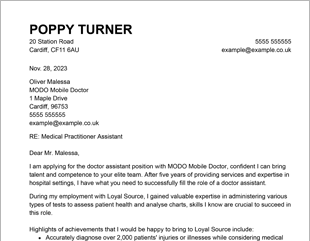A Fantastic Physical Therapy Cover Letter Example
Use this physical therapy cover letter example to showcase your expertise and skills as a physical therapist. Check out our cover letter builder for more help.
Use this physical therapy cover letter example to showcase your expertise and skills as a physical therapist. Check out our cover letter builder for more help.





OUR USERS HAVE BEEN HIRED BY
A physical therapist’s main duty is to perform treatments and exercises to help patients recover from illnesses and injuries. To do this, they need a range of skills and expertise to both supply medical care and set the patient at ease. They need to know various treatment techniques to develop personalised treatment plans, prescribe medications to relieve pain and increase the general mobility and health of patients. A professional cover letter should demonstrate that you can perform these duties.
This guide will give you:
Knowing where to begin with your cover letter can be a challenge. Take a look at this physical therapy cover letter sample for some inspiration before starting to build your cover letter.
Here are five tips to consider when writing your physical therapy cover letter:
You must share your contact information where it is easily visible to the hiring manager so that they can contact you to schedule a job interview. Include your information right at the top of your cover letter in the header. Include your full name, address, email, phone number and any links to your job networking profiles.
Any recruiter wants to see evidence that you have carefully read the job description and the job posting. Customise your cover letter for each job you apply for to show that you have taken the time to understand the role’s responsibilities and explain why you are the right person to fulfill them. Use keywords and skills outlined in the job description when describing your talents. This demonstrates to the hiring manager that you have the skillset necessary to excel in the role.
Quickly outline your strengths in the first paragraph to frame yourself as a viable candidate. You should try to hook the reader with your career highlights. This provides a solid base to build upon in the rest of the cover letter. This may be a reference to your experience as a physical therapist or a physical therapist assistant, an outstanding skill, or evidence of your expertise and knowledge. This is your chance to make a good first impression so the hiring manager wants to continue reading your cover letter.
In the second paragraph of your cover letter, you should outline some reasons why you are the perfect fit for the advertised role. Expand on your CV, drawing the line between your previous experience and the advertised role. This is all about building up a picture of you as an individual to convince the recruiter to invite you to interview. Give evidence, reference certifications and highlight skills to show that you’re the best person for the role.
Just as your opening salutation is professional and polite, your final paragraph should thank the recruiter for their time. Point to your attached physical therapist CV for more details, then encourage them to take the next step with a call to action. This shouldn’t be too direct. Just say you are looking forward to discussing the role further, either in a phone call or at an interview.
Yes. You should always write a cover letter to complete your job application. It allows you to build on the details of your CV by sharing a more personal touch and creating a better picture of you as an individual. Word your cover letter wisely to set yourself apart from other job candidates. Use our CV writing tips and CV examples to create a CV. Then back up your CV with the perfect cover letter using sample cover letters and a cover letter builder. Take these steps to give yourself the best chance of landing that new job.
Your cover letter should be around three-quarters of a page long. If you follow our cover letter templates and the cover letter format outlined above, you’ll see that this gives you enough space to share details without overloading the hiring manager with information. Remember, the cover letter is still a prelude to an interview.
Yes, you can still use this cover letter for physical therapist jobs, even if you don’t have much experience. While you will need to share your certifications and education details, you can swap out any references to previous experiences with your other strengths or extracurricular or volunteer activities that display skills that can help you fulfill the role’s duties.
We personalize your experience.
We use cookies in our website to ensure we give you the best experience, get to know our users and deliver better marketing. For this purpose, we may share the information collected with third parties. By clicking “Allow cookies” you give us your consent to use all cookies. If you prefer to manage your cookies click on the “Manage cookies” link below.